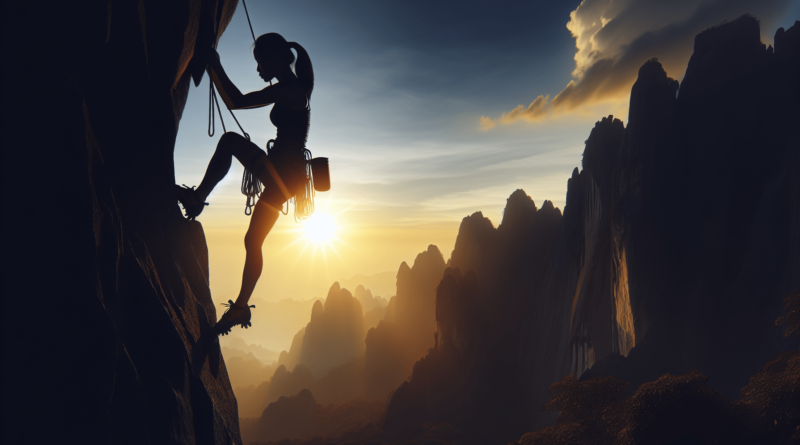Mountain Climbing
In the realm of adventure, nothing compares to the thrill of mountain climbing. The surge of adrenaline as you ascend steep slopes, the chilling winds brushing against your cheeks, the crunch of snow under sturdy boots, and finally, the unparalleled joy of conquering the summit; mountain climbing is not merely a sport, it’s an experience of a lifetime. This article encapsulates the essence of mountain climbing by exploring its multifaceted dimensions. Enjoy the journey as you traverse through some fascinating insights drawn from the world’s highest peaks, to the essential equipment and training required, along with firsthand accounts from seasoned climbers. Prepare to scale new heights and explore the allure of altitude.

Understanding Mountain Climbing
Mountain climbing, also known as mountaineering, is an exhilarating and challenging outdoor sport that involves ascending to the summit of high terrain, often via routes that involve rock, ice, and snow. As you navigate the tour of this captivating outdoor activity, you’ll discover the rich history, various techniques, gear, and the profound benefits it offers.
Origin and History of Mountain Climbing
The birth of modern mountain climbing is considered to date back to the mid-eighteenth century, when Swiss scientist Horace-Bénédict de Saussure offered a cash reward to the first person who could reach the summit of Mount Blanc, the highest peak in the Alps. But it was much before that, the human curiosity and spirit of adventure had been leading them towards the heights. Regardless of the history, mountain climbing represents the allure of the challenge and the quest for a stunning perspective.
Different Types of Mountain Climbing
There are different types of mountain climbing for different adventure levels, starting from hiking on well-defined trails to extreme mountaineering. It could be distinguished into traditional rock climbing, ice climbing, bouldering, and mixed climbing that combines rock and ice climbing. Choose what type calls to your adventurous spirit, and also, suit your current fitness level and climbing skills.
Preparing for a Mountain Climb
An ascent requires diligent preparation, of both, your body and mind.
Physical Training and Fitness Level
From a physical perspective, start conditioning your body for endurance, strength, and flexibility long before the climbing day. Invest in cardio exercises, strength training, core work outs and regular mountain climbing practice on smaller peaks.
Planning: Route and Weather Conditions
Plan your route well in advance considering your capabilities. Always keep an eye on the weather forecast – in the mountains, weather can change drastically and rapidly. Understanding the impact of weather on climbing conditions is crucial.
Assembling a Team
Try not to take on a serious climb alone. Assembling a team of climbers with varied skills can ensure safety and make the ascent more manageable. Trust and good communication within the team are key.
Preparation Timeline
Your preparation timeline will depend on the complexity and altitude of the climb, generally it could range from several months to a year. Don’t rush, proper acclimatization and building physical strength need time.
Necessary Mountain Climbing Gear
On to the nitty-gritty, let’s look at the essential mountain climbing gear.
Mountain Climbing Clothes
The rule of thumb with mountain climbing clothes is layers, layers, and more layers! Dress in clothes that are breathable, insulated, and waterproof. Don’t forget a sturdy pair of mountain climbing boots.
Climbing Equipment: Types and Uses
Equip yourself with a climbing harness, ropes, carabiners, cams, nuts, ice axes, crampons, helmets and more, essentially they provide safety and aid climbing.
Food, Water, and First Aid Supplies
Carry high-energy food, enough water, and first aid supplies. Remember, you’re exerting yourself at high altitudes and the last thing you want to worry about is dehydration or untreated injuries.

Understanding Mountain Climbing Techniques
Having the right skills can make your climb smoother and safer.
Basic Climbing Moves
You should be familiar with basic climbing moves – from hand jams and manteling to stemming and smearing. These techniques can help you navigate the rocky terrain effectively.
Rope Handling and Knot Tying Techniques
Master the art of rope handling and knot-tying techniques, it forms the backbone of mountain climbing safety.
Belaying and Rappelling Techniques
Belaying and rappelling are integral skills. They ensure that you climb safely and can importantly aid during descend or in case of slips.
Safety Measures and Emergency Preparations
Preparing for emergencies is as important as preparing for the climb itself.
Risk and Hazard Assessment
Part of your safety measures includes risk and hazard assessments. Always inform someone of your climbing plan and expected return time.
Emergency Evacuation Plan
Have an emergency evacuation plan in place. This includes knowing the quickest routes down and the closest points of safe shelter.
Handling Altitude Sickness and Hypothermia
Altitude sickness and hypothermia are significant risks in mountain climbing. Understand the symptoms, prepare for them, make sure your body is gradually acclimatizing to high altitude, and always keep warm clothing and gear.
Understanding Weather Conditions and Their Impact
Weather can be the game-changer.
Weather Predictions in Mountain Climbing
Understanding weather predictions for the area you are climbing is critical. The weather in mountainous areas can change rapidly, making conditions dangerous.
Effects of Different Weather Conditions
Weather effects could range from low visibility to slippery surfaces or increased risk for hypothermia and frostbite.
Safety Measures in Adverse Weather
Be prepared with safety measures for adverse weather – GPS-aided navigation, stormproof tents, and plans to shelter on climbs with high exposure.
Environmental Stewardship and Mountain Climbing Ethics
Mountain climbers are often the most passionate advocates for environment conservation.
Following Leave-No-Trace Principles
Always follow the leave-no-trace principles, take all your trash with you, and don’t damage flora.
Respecting Wildlife
Respect the wildlife you may encounter. If you are quietly observant, your climb can be a wonderful opportunity to appreciate mountain ecology.
Minimizing Impact on Local Communities
You should always endeavour to minimize your impact on local communities. Meet them with respect, understand their customs and traditions, and contribute where you can.
Famous Mountain Climbs and Climbers
There have been some monumental climbs and climbers in the history.
Notable Climbers in History
Notable climbers include Sir Edmund Hillary and Tenzing Norgay, who were the first confirmed summiteers of Mount Everest in 1953.
Famous Mountain Climbing Expeditions
Famous mountain climbing expeditions include the British Everest Expedition in 1953 and the first ascent of K2 by the Italian expedition in 1954.
Record-breaking Mountain Climbs
Reinhold Messner was the first to summit all fourteen 8000-meter peaks without oxygen, a record-breaking feat that many consider the pinnacle of mountaineering achievement.
Health Benefits of Mountain Climbing
Believe it or not, mountain climbing is much more than just an adrenaline rush.
Physical Health Benefits
Mountain climbing offers immense physical health benefits, ranging from improved cardio-respiratory system, strength and endurance to better mobility and balance.
Mental Health Benefits
Mountain climbing can also promote mental health by boosting your mood, reducing stress, and teaching resilience.
Life Lessons Learned from Mountain Climbing
Mountain climbing invariably teaches valuable life lessons – persistence, patience, meticulous planning, risk management, and thriving through adversity, to name a few.
Concluding Thoughts on Mountain Climbing
In the end, remember it’s not about ticking another summit off your list.
Reflection on the Risks and Rewards
Reflect on the risks and rewards. While it’s easy to get swept in the thrill, the dangers are real. Make mountain climbing a way to respect and appreciate the environment and your own strengths and limitations.
Future of Mountain Climbing
And, no matter the challenges faced, the future of mountain climbing shines bright as ever with the continuing evolution of gear, technology and brave-hearted individuals ready for the adventure.
Celebrating the Mountain Climbing Community
Let’s celebrate the mountain climbing community – the fraternity of humble, courageous, and toiling adventurers, who demonstrate unparalleled resolve, and cultivate deep respect for the grandeur of the mountains.
As you venture into mountain climbing, know that it is a journey, both exhilarating and arduous. But in the end, every step taken in preparation, anticipation, and finally, conquest, makes you stronger in spirit and richer in memories. Happy Climbing!



